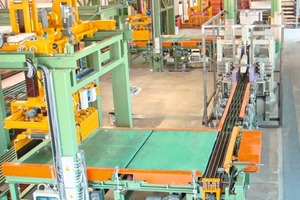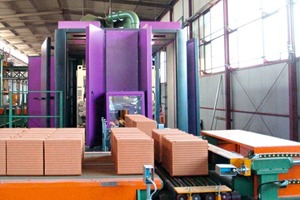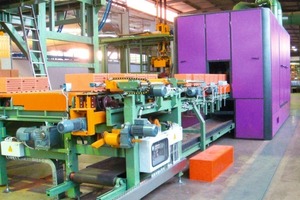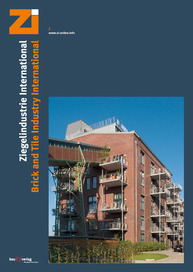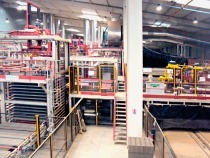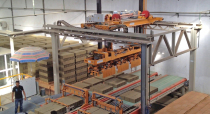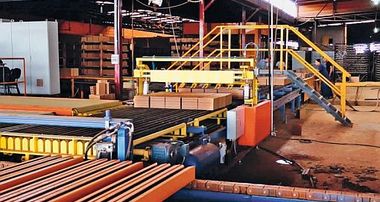New rectifying line puts Fornaci Zanrosso brickworks into a top position
Rectified masonry blocks are used mainly in Central Europe. Brick rectification was started in the 1980s in Germany, where the blocks were developed as a competitive product for cement blocks, which as a rule are cheaper and faster to lay than classical bricks. With the use of rectified bricks, work can be carried out with a very thin mortar layer, which not only improves the thermal insulation but also allows faster building times. In the 1980s, 90 minutes were required to lay one square metre of 38 cm size blocks, whereas today only 40 minutes are needed, while achieving a higher degree of precision with simplified work sequences. The advantages offered by this technology on the building site, however, are set against the higher expenditure for the manufacture of the blocks. For the brick manufacturer, an additional production step results, since the blocks have to be removed and prepared for grinding. Depending on the height of the blocks, rectification is carried out in one or two superimposed layers.
In autumn 2006 Zanrosso had the innovative idea of introducing rectified fired bricks on the Italian market. Later, in mid 2008, they embarked on a detailed study in collaboration with their historical supplier Marcheluzzo Impianti, who already had experienced the process in other units: for example at the renowned companies Wienerberger and Terreal, where double-line rectification plants were installed. Thus Marcheuzzo was in the best position to offer advanced and smoothly running technical solutions. Special attention was paid to the handling system for the fired products, which had to be combined with the chosen grinding line in order to achieve high-quality products and the greatest possible plant flexibility. The rectifying wheel of the Wassmer grinding line installed at Zanrosso features a larger diameter than most of the competing products on the market, which allows a better cleaning out the waste grinding powder at the same working speed. This machine belongs to a new generation with innovative transport and handling solutions for the products during the grinding action, which substantially reduces the difficulties in the adaptation of tools to the raw material. Furthermore the machine is equipped with two preparation wheels which reduce chipping of the blocks as these are fed to the two large wheels.
An electronic measuring system is fitted at the entry, at the intermediate position and at the exit of the machine, in order to keep under control the wearing condition of the tools and to optimize their efficiency. The machine is in the position to check constantly the performance of the wheels and obtains the exact evaluation of the processing for tools and energy consumption, which form the main cost factor of this machine.
Another important aspect is the removal of the grinding dust and Zanrosso entrusted Hellmich with this task. The extraction plant installed at Zanrosso comprises a filter and an attached pneumatic transport line around 100 m long, through which the dust is returned to the production process. Here it can be reused in the clay preparation or to reduce the raw material moisture in the production process. Thanks to the positioning of the suction system inside the Wassmer grinding machine and the sufficiently dimensioned filter, this system achieves very good results; dust deposits inside the machine are prevented. Furthermore the dust can also be extracted at critical points on the transport line after the grinding machine, for example at the place where the blocks are turned and the dust falls out of the perforations. If required, the grinding dust can be packed in big bags to avoid any dispersion during the transport to other areas.
In order to ensure the least possible noise disturbance, specialists from a Company working in this field, together with Marcheluzzo Impianti, carried out measurements on already existing Wassmer grinding plants under real production conditions. On the basis of the measured values a sound-proof test cabin was built, taking into account all the main process factors: access to the grinder for the routine and extraordinary maintenance, access of the operator for checks, double chicane at the entry and the exit for the best possible noise absorption, without altering the inlet of air necessary for sucking up the grinding dust and for cooling the grinding wheels.
The plant was then completed by Marcheluzzo Impianti with the installation of the handling line, which offers various possibilities for material transport. On the one hand it can work in direct line for off-loading the kiln cars, supply to the rectifying zone, and then to the existing packaging line. Otherwise it is also possible just to feed the grinder with pallets of finished products taken from the yard, transporting them to the pack splitting zone, then conveying the products to the grinder and transporting them again to a specific zone for the final composition of the pack.
Special care was devoted to the layout of the transport system, in which the Marcheluzzo Impianti technicians, on the basis of their great experience accumulated over the years, worked out the perfect compromise between wear reduction and the greatest possible flexibility in material treatment. Functional solutions were also implemented for the gripper for primary splitting of layers and the formation of individual rows of modules, together with appropriate deviations and movements for turning the blocks before and after the grinder. Another delicate point was the zone at the entry of the grinder, because here space for handling the products was extremely restricted, since the customer desired a flexible solution for different block sizes. Faulty products or broken parts are sorted out through a conveyor which transports them to a proper storing box.
Altogether the project was planned and designed so that the plant can be maintained and operated easily with the minimum personnel required. Compliance with all necessary safety measures for this innovative and special plant was a great challenge for Marcheluzzo Impianti.
The absolutely successful implementation of the project was decisive for the fact that Zanrosso allowed the publication of details
although the project initially had an experimental character, since the acceptance of such an innovative product manufactured on a new type of plant could not yet be
assessed on the Italian market.
Once again Zanrosso has demonstrated far-sightedness and potential for innovation. This has allowed the firm to withstand the deep economic crisis without suffering major losses of turnover. The technical solutions developed by the company contribute to strengthening the importance of brick for building in general.

